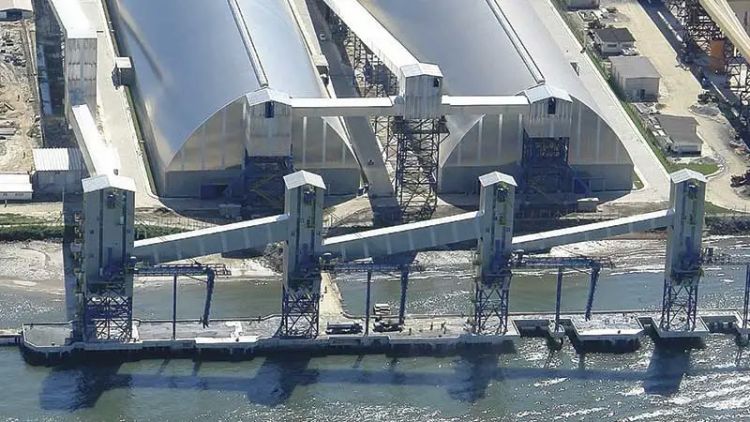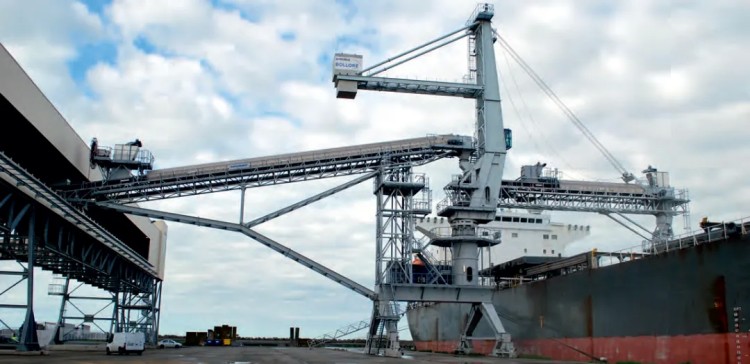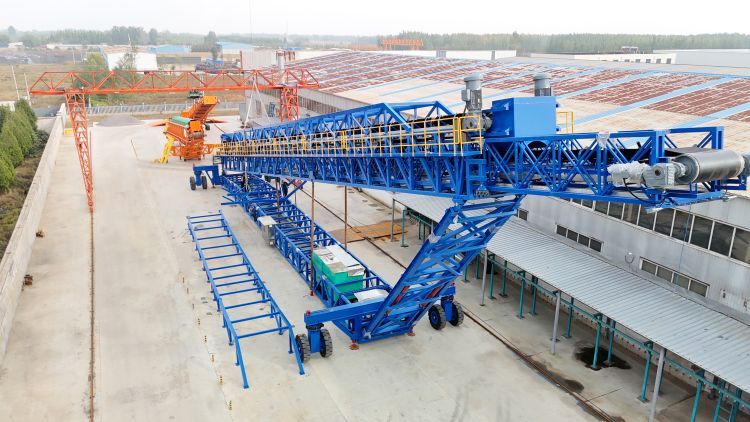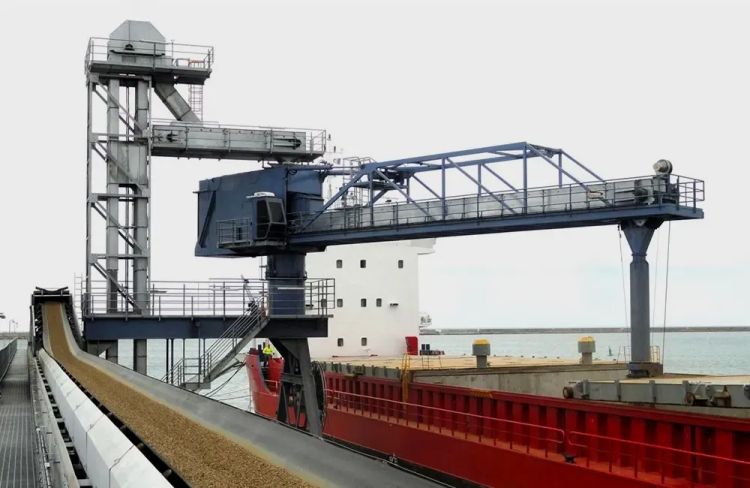Time:2025-01-13 16:31:59 Number of Clicks:
In the global grain trade, efficient shiploading methods not only impact port throughput but also determine overall logistics costs. With the advancement of shiploading technology, the mobile shiploader has become an essential tool for bulk grain loading. Given the high operational requirements for grain and cereal handling—including breakage rates, operational efficiency, energy consumption, noise, investment, and environmental impact—certain mobile shiploader models face limitations. As a result, various shiploading modes have been developed to accommodate different port conditions and transportation needs.
This shiploading method is widely used in major grain-exporting countries such as Brazil. The core concept involves using an enclosed transfer tower to transport material from the dock to the shiploader boom for final loading.
This system utilizes multiple (typically 3–4) transfer towers to seamlessly connect the dock conveyor to the shiploader. The boom has a fixed length and is equipped with a hydraulic swinging mechanism that adjusts the discharge angle to ensure even distribution in the ship’s hold. Some designs allow boom rotation up to 180 degrees, or even 270 degrees, to accommodate various shiploading requirements.
The main advantage of this system lies in its efficiency and continuous operation. Changing holds does not require stopping the system; instead, simply adjusting the transfer direction allows for smooth cargo redirection. Additionally, the compact design minimizes the footprint, optimizing port space utilization and reducing overall investment costs. The enclosed structure also significantly reduces dust emissions, improving environmental sustainability.
Despite its advantages, this method has some limitations. The fixed loading range restricts adaptability to different ship sizes. Moreover, the multiple transfer towers increase potential blockage points, meaning that a failure at any stage could disrupt the entire shiploading process.

Compared to the tower-based system, the traveling tail conveyor shiploader offers greater flexibility and can adapt to different vessel types. It is widely used in bulk grain transportation.
The system connects to the upstream conveyor via a traveling tail section, ensuring smooth material transition to the shiploader boom. The boom can adjust its inclination, rotate, and extend its loading spout, allowing precise cargo placement based on the ship’s hold layout.
The primary advantage of this system is its adaptability. It can accommodate varying water levels and ship sizes, making it a versatile solution for grain export terminals. The enclosed conveyor structure also minimizes dust emissions, meeting environmental regulations.
However, this system requires more space at the dock, as the traveling tail section needs a long rail track, increasing the occupied area. Additionally, during hold changes, a brief stoppage is necessary to switch material flow, which may slightly impact loading efficiency.

This method utilizes multiple fixed discharge points on the conveyor system in combination with a mobile belt conveyor to complete shiploading. It is particularly suitable for small vessels or scenarios requiring high flexibility.
The system employs fixed discharge points and chutes to direct material into the mobile shiploader without requiring complex transfer structures. The conveyor system can be equipped with plow or throw-off discharge mechanisms to enhance unloading precision.
This system simplifies the shiploading process, reducing equipment height requirements and optimizing overall port layout. The mobile belt conveyor is well-suited for low-freeboard vessels, allowing flexible adjustment of loading angles. Additionally, it lowers overall equipment investment costs.
A key drawback of this method is that the mobile shiploader needs to realign with the discharge chute after each movement, leading to brief operational pauses that affect efficiency. Additionally, due to the lack of a rotating mechanism, its adaptability for large vessels is somewhat limited.
For inquiries about efficient bulk grain shiploading solutions, contact us:

The bucket elevator mobile shiploader integrates bucket elevator technology to optimize material flow and improve shiploading efficiency, making it ideal for large-scale grain export operations.
Unlike traditional mobile shiploaders, this system features a bucket elevator that lifts material vertically. After a short incline via the upstream conveyor, the material enters the bucket elevator, which elevates it to the desired height before transferring it to the shiploader boom for final delivery into the vessel.
This design reduces the height requirements of the conveyor path, minimizing dock length occupation. Additionally, due to the enclosed bucket elevator structure, dust emissions are effectively controlled, meeting environmental standards. The optimized material trajectory also enhances overall loading efficiency.
The main challenges of this system are its high complexity and maintenance requirements. Furthermore, the bucket elevator works best with free-flowing grains; certain sticky materials may cause transportation issues.

Different mobile shiploader types are suited for different operational scenarios. Selecting the appropriate shiploading solution requires careful consideration of port conditions, vessel specifications, efficiency needs, and environmental factors. The tower-based system is ideal for high-throughput applications, while the traveling tail shiploader provides greater flexibility. The fixed discharge point + mobile belt conveyor system is cost-effective for small vessels, whereas the bucket elevator mobile shiploader excels in efficiency and environmental performance, particularly for major grain export terminals.
In the future, as automation and intelligent control technologies advance, mobile shiploaders will continue to evolve—enhancing efficiency, reducing energy consumption, and improving environmental protection—providing smarter and more efficient solutions for global bulk grain transportation.
Copyright © 2002-2024 Zoomry Group Company Limited